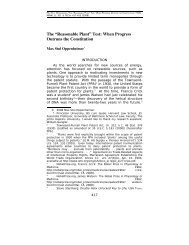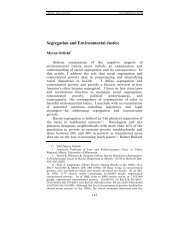An Organizational Approach to the Design of Patent Law
An Organizational Approach to the Design of Patent Law
An Organizational Approach to the Design of Patent Law
You also want an ePaper? Increase the reach of your titles
YUMPU automatically turns print PDFs into web optimized ePapers that Google loves.
6 VERTINSKY FINAL_JAD (DO NOT DELETE) 2/27/2012 2:20 PM<br />
2012] AN ORGANIZATIONAL APPROACH 273<br />
cusing on cognition provides a useful context for exploring <strong>the</strong><br />
characteristics, motivations, and decision-making <strong>of</strong> <strong>the</strong> entrepreneur,<br />
with implications for how patents might influence behavior.<br />
261 There is at least anecdotal evidence that patents<br />
could have an empowerment function. 262 The notion that one<br />
can “own” <strong>the</strong>ir own ideas and create valuable assets out <strong>of</strong><br />
<strong>the</strong>ir own intellectual efforts can encourage individuals <strong>to</strong> pursue<br />
<strong>the</strong>ir initiatives in a business world that <strong>the</strong>y might o<strong>the</strong>rwise<br />
feel was inaccessible. There is both a psychological component<br />
and a practical business component <strong>to</strong> <strong>the</strong> notion <strong>of</strong><br />
intellectual property as property that can be self-created, with<br />
limited external resources. At <strong>the</strong> broader social level, cultural<br />
and social understanding about patents and intellectual property<br />
ownership more generally could create a climate conducive<br />
<strong>to</strong> entrepreneurship, just as <strong>the</strong> bankruptcy laws and <strong>the</strong> acceptability<br />
<strong>of</strong> failure has been thought <strong>to</strong> contribute <strong>to</strong> <strong>the</strong> willingness<br />
<strong>to</strong> engage in risky new ventures. 263 General norms<br />
about risk taking and his<strong>to</strong>rical practices <strong>of</strong> investment might<br />
be influenced by patent policies, influencing at least <strong>the</strong> financing<br />
<strong>of</strong> entrepreneurial activities. The different psychologies <strong>of</strong><br />
creativity and scientific or technical invention may also justify<br />
differences in formal rules. 264 Recognizing <strong>the</strong> interaction between<br />
informal rules and formal rules, <strong>the</strong> organizational approach<br />
captures <strong>the</strong> potential <strong>of</strong> entrepreneurial acts and beliefs<br />
<strong>to</strong> shape <strong>the</strong> direction <strong>of</strong> innovation and influence <strong>the</strong> roles<br />
that patents may play in innovation processes. 265<br />
261. See, e.g., Shyamkrishna Balganesh, Foreseeability and Copyright Incentives,<br />
122 HARV. L. REV. 1569 (2009); Jonathan Remy Nash & Staphanie M.<br />
Stern, Property Frames, 87 WASH. U. L. REV. 449 (2010); Jennifer W. Scangos,<br />
Comment, Instinct and Rationality: <strong>An</strong> Evolutionary <strong>Approach</strong> <strong>to</strong> Intellectual<br />
Property <strong>Law</strong>, 15 INTELL. PROP. L. BULL. 65 (2010).<br />
262. For anecdotal evidence, see <strong>the</strong> life and work <strong>of</strong> National Foundation<br />
for Teaching Entrepreneurship founder Steve Mariotti. But see Torrance &<br />
Tomlinson, supra note 143, at 135.<br />
263. See generally Mike W. Peng, Yasuhiro Yamakawa, & Seung-Hyun<br />
Lee, Bankruptcy <strong>Law</strong>s and Entrepreneur-Friendliness, 34 ENTREPRENEURSHIP<br />
THEORY AND PRACTICE 517 (2009).<br />
264. See Jeanne C. Fromer, A Psychology <strong>of</strong> Intellectual Property, 104 NW.<br />
U. L. REV. 1441, 1443 (2010) (examining patent laws and copyright laws in<br />
light <strong>of</strong> psychology literature on creativity and different aspects <strong>of</strong> <strong>the</strong> creative<br />
processes for different works and inventions).<br />
265. See, e.g., Sarah Kaplan & Fiona Murray, Entrepreneurship and <strong>the</strong><br />
Construction <strong>of</strong> Value in Biotechnology, 29 RES. IN THE SOCIOLOGY OF ORG.<br />
107, 107–8 (2010) (“[T]he burgeoning literature on institutional entrepreneurship<br />
. . . argues precisely that nei<strong>the</strong>r <strong>the</strong> technology nor <strong>the</strong> institutional environment<br />
is fixed and that multiple ac<strong>to</strong>rs with multiple goals . . . act <strong>to</strong>






